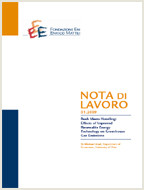Sharing R&D Investments in Cleaner Technologies to Mitigate Climate Change

07.04.2014
Abeer El-Sayed and Santiago J. Rubio
D74, F53, H41, Q54, Q55
International Environmental Agreements, R&D Investment, Technology Spillovers, Coalition Information Exchange, Research Joint Ventures
Climate Change and Sustainable Development
Carlo Carraro
This paper examines international cooperation on technological development as an alternative to international cooperation on GHG emission reductions. It is assumed that when countries cooperate they coordinate their investments so as to minimize the agreement costs of controlling emissions and that they also pool their R&D efforts so as to fully internalize the spillover effects of their investments in R&D. In order to analyze the scope of cooperation, an agreement formation game is solved in three stages. First, countries decide whether or not to sign the agreement. Then, in the second stage, signatories (playing together) and non-signatories (playing individually) select their investment in R&D. Finally, in the third stage, each country decides its level of emissions non-cooperatively. For linear environmental damages and quadratic investment costs, our findings show that the maximum participation in a R&D agreement consists of six countries and that participation decreases as the coalition information exchange decreases until a minimum participation consisting of three countries is reached. We also find that the grand coalition is stable if the countries sign an international research joint venture but in this case the effectiveness of the agreement is very low.
***
Suggested citation: El-Sayed, A.,S. J. Rubio, (2014), ‘Sharing R&D Investments in Cleaner Technologies to Mitigate Climate Change’, Nota di Lavoro 41.2014, Milan, Italy: Fondazione Eni Enrico Mattei.
